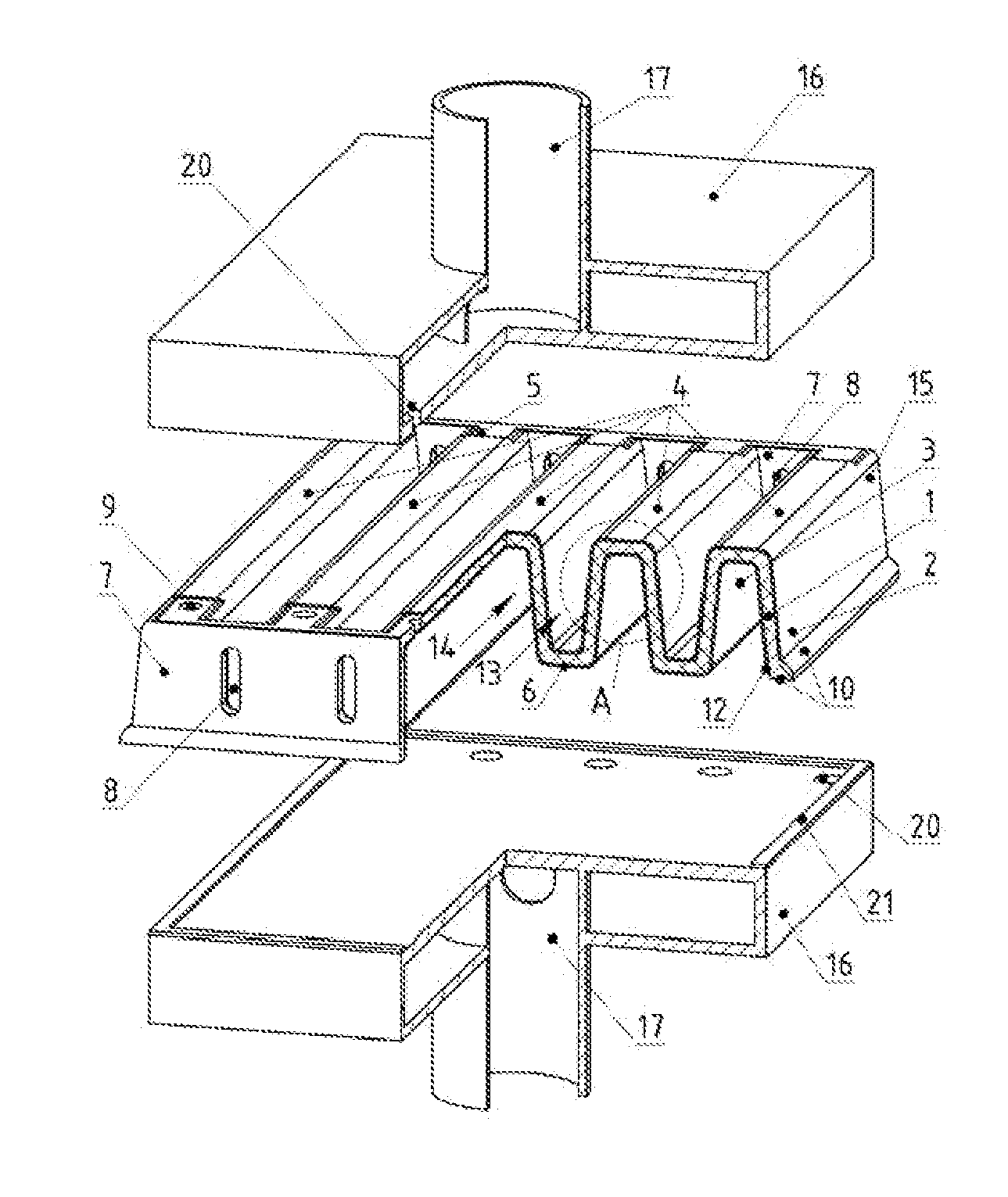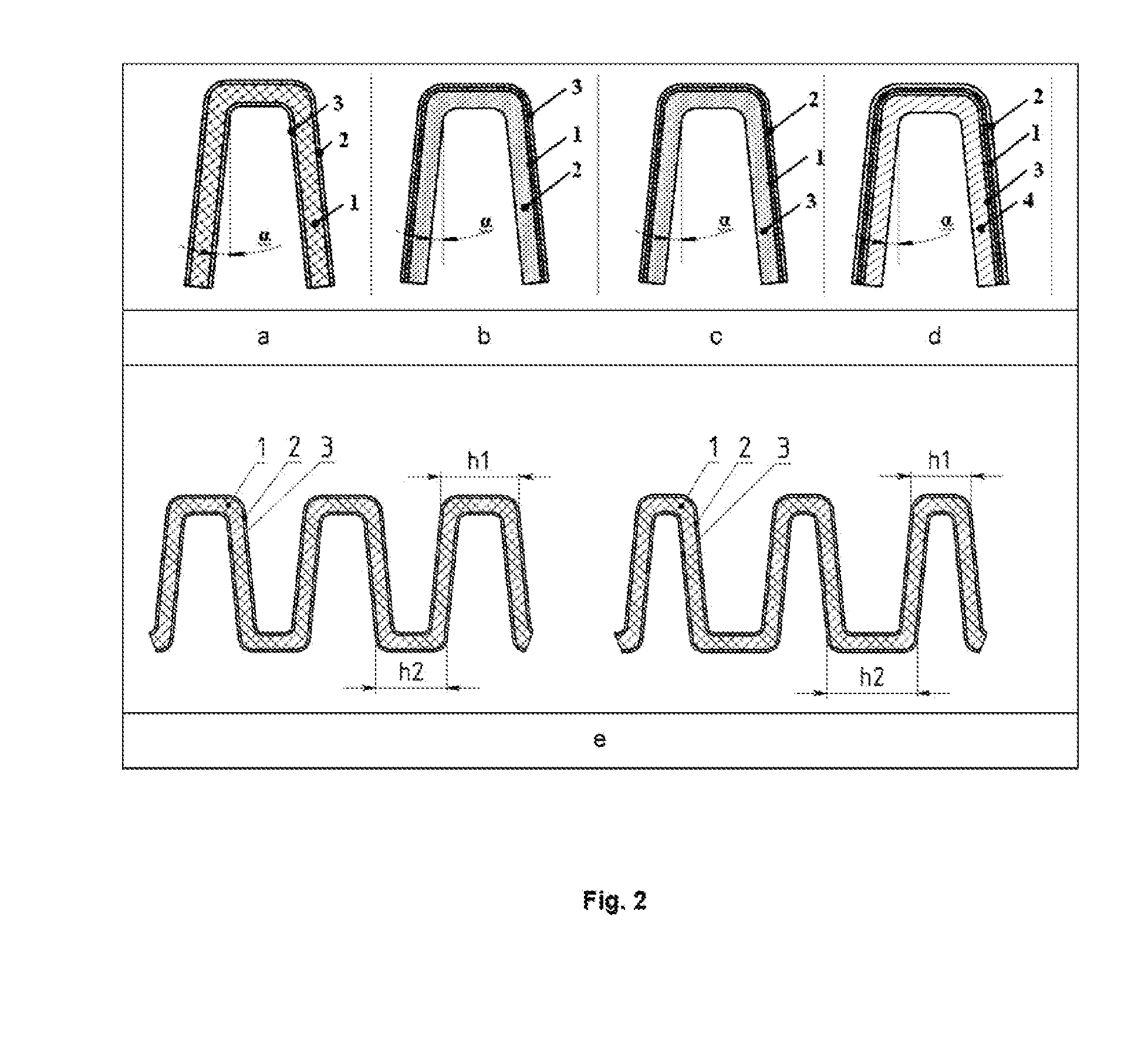Modified planar cell (MPC) and electrochemical device battery (stack) based on MPC, manufacturing method for planar cell and battery, and planar cell embodiments
a technology of electrochemical device and planar cell, which is applied in the direction of fuel cell, baking, dough shaping, etc., can solve the problems of affecting the complexity of sealing connection of gas manifolds at the input and output of reagents in the cell and battery, and the inability to estimate specific characteristics without, so as to improve the uniformity and inter-space pressure of reagent feed and increase the packing density. density, the effect o
- Summary
- Abstract
- Description
- Claims
- Application Information
AI Technical Summary
Benefits of technology
Problems solved by technology
Method used
Image
Examples
sixth embodiment
[0064]the planar cell is shown in FIG. 5.
[0065]In this case, the modified planar cell with electrochemical part 15, for example, with supporting solid electrolyte 1 and electrodes, cathode 2 and anode 3, has two rows of apertures: one row, for example, the upper one, includes apertures 9 in the front and rear walls 7 made from solid electrolyte or structural ceramic for fuel supply into -shaped channels. The other row, for example, the lower one, contains apertures 8 with a larger section for air supply into -shaped SOFC channels and for hypoxic mixture removal from the planar cell. The lower and upper rows of apertures are located on the front lateral wall. If the battery is manufactured from a series set of cells along the vertical axis, it is reasonable to use the structure of the planar cell electrochemical part as end cells. The upper gas and current manifold 16 is manufactured from electron conducting material, for example, high-chromium steel, e.g. Crofer 22 APU. It is connec...
first embodiment
[0066]For a series electrical connection of the planar cells, as well as for higher voltage generation, the planar cells (variants) can be assembled into the battery (the first variant) along the vertical axis. In this case, each subsequent cell is rotated by 180, FIG. 6 (as an example the figure shows the planar cell).
[0067]The battery consists of several cells 15 (as an example only two cells are shown) and has input and output gas manifolds 16 with the metallic box-like gas supply ducts 17 for fuel supply and reaction products removal correspondingly. The metallic box-like gas supply ducts 17 simultaneously serve as current collectors (clamps) of the battery. The metallic box-like gas supply ducts 17 inside box-like gas manifolds 16 have an aperture for uniform distribution of reagent gas flows in the planar cell by apertures 9. These metallic box-like gas supply ducts 17 are connected mechanically and electrically with a gas distributing plate with apertures 20 and gas manifold ...
second embodiment
[0069]FIG. 7 shows the battery.
[0070]Structurally, the electrochemical and ceramic part, the fuel distribution, the fuel and oxidant supply assemblies, and the reagent removal assemblies are provided in a manner similar to those of the single cell. However, the corrugated plate 4 from the solid electrolyte (see prototype, FIG. 3 and FIG. 1, 4, 5) has several pairs of electrodes rather than two electrodes, one as a cathode at the top and a second as an anode at the bottom. Thus, one ceramic blank may represent one SOFC comprising five -shaped fuel channels and four -shaped air channels, or such ceramic blank may represent a battery of two cells, if the anode of the left cell (2.5 of -shaped channels) is electrically connected with the cathode of the right cell (2.5 of -shaped channels) and the third -shaped fuel channel. The battery is formed of five cells, if each -shaped fuel channel is a cell, and their series electrical connection is an anode of the previous cell with a cathode o...
PUM
| Property | Measurement | Unit |
|---|---|---|
| Angle | aaaaa | aaaaa |
| Angle | aaaaa | aaaaa |
| Length | aaaaa | aaaaa |
Abstract
Description
Claims
Application Information
 Login to View More
Login to View More - R&D
- Intellectual Property
- Life Sciences
- Materials
- Tech Scout
- Unparalleled Data Quality
- Higher Quality Content
- 60% Fewer Hallucinations
Browse by: Latest US Patents, China's latest patents, Technical Efficacy Thesaurus, Application Domain, Technology Topic, Popular Technical Reports.
© 2025 PatSnap. All rights reserved.Legal|Privacy policy|Modern Slavery Act Transparency Statement|Sitemap|About US| Contact US: help@patsnap.com



